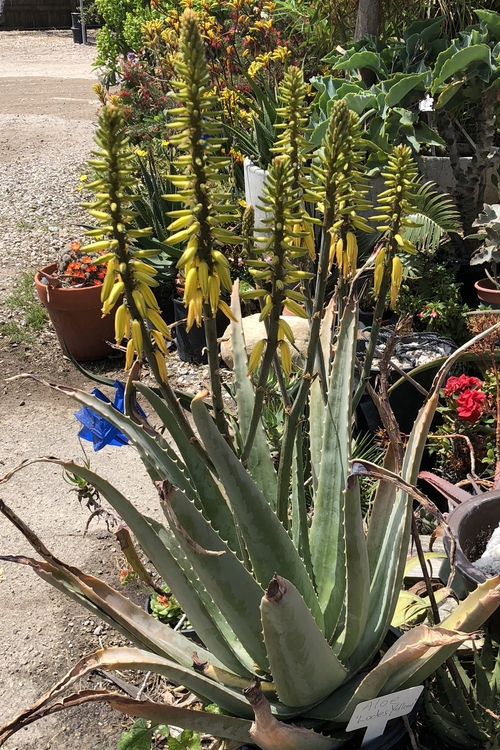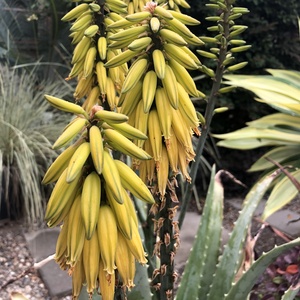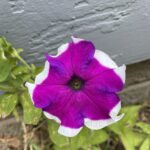This is the story of the illusive, endangered, and mysterious hybrid we call Aloe ‘Lode’s Yellow’. From accidental origins to controlled cultivation, and now a risk of extinction – learn all about my journey uncovering this remarkable story!
What is Aloe ‘Lode’s Yellow’?
At first glance, this plant could fool you into thinking it is a common Aloe vera due to its yellow flowers, but the leaves grow long and slender, edged with gentle teeth and coated in a grey powder, unlike Aloe vera‘s thick, sturdy leaves.
In the garden, this difference is striking. Aloe ‘Lode’s Yellow’ combines the beauty and familiarity of Aloe vera, with the hardiness and wild growth of Aloe koenenii. It thrives in dry, sunny conditions, tolerates drought well, and produces blooms that feel both unusual and timeless. For collectors, it is a perfect mix of traits.
The Discovery
When I first saw it online, I was struck by how familiar and unfamiliar it looked at the same time. The yellow flowers resembled Aloe vera, a plant almost everyone recognizes; however, the greyish-powdery leaves took the form of Aloe koenenii, a species native to Petra, Jordan. Combined, the two traits created something unique: a plant that could easily be mistaken for A. koenenii at first glance, until the golden blooms opened and revealed its mystery.

A Plant Without a Past
I first discovered this plant online at San Marcos Growers, a California nursery known for introducing unusual plants to the U.S. market. They shared how ‘Lode’s Yellow’ first appeared in a Santa Barbara garden and was grown by plantsman Tim Harvey from seed labeled Aloe porphyrostachys ssp. koenenii. That seed came from French researcher and explorer Joël Lodé.
The assumption was simple: this was A. koenenii– until the flower color told another story. Where koenenii should bloom red to orange, these plants were unmistakably yellow.
Following the Trail Back to Joël Lodé
Curious, I dug into Lodé’s background. For decades, he has collected and cultivated rare aloes across the world, often mixing them in cultivation with more common species such as A. vera. In his breeding facilities, he allowed pollinators to move freely between plants.
This gave me a theory. If bees had moved between A. vera and A. koenenii, the result could be a hybrid carrying the structure of one and the coloring of the other. ‘Lode’s Yellow’ fit that description exactly.
A Theory of Hybrid Origins
I reached out to Lodé directly to share my theory. He confirmed that he, too, suspected ‘Lode’s Yellow’ to be the result of A. vera and A. koenenii crossing naturally. He had never intentionally made the cross. Instead, he first learned of the plant when a San Marcos Growers employee, Randy Baldwin, contacted him after the plant was brought into cultivation.
Lodé even shared with me some unpublished notes on his decades-long struggle to work with A. koenenii. These records, written in his own words, provide a rare glimpse into the challenges of aloe pollination.
Excerpts from Joël Lodé’s Notes
“During my travels to Petra (Jordan) in 1985, I discovered the species Aloe koenenii, but because this species does not produce many offsets, and they take much time to flower, my aim was to pollinate them for seed when my other clones would flower.”
“Finally, in 2010, after many hand-pollination attempts every morning and afternoon, a few seedpods appeared in some of the stalks. I was able to collect the first seeds, which were sown, proving them to be viable.”
“Even though we have gained more experience on Aloes after decades of cultivation, Aloes still have some secrets in their fruiting behaviour.”
These reflections highlight just how unlikely it was for A. koenenii to produce seed at all, and why the hybridization with vera could have happened only under very specific circumstances.
Sidebar: The Rare Aloe of Petra – Aloe koenenii
Discovered in 1985 by Joël Lodé during his travels to Petra, Jordan, Aloe koenenii is a species as remarkable as the ancient city where it grows. Petra, famous for its rock-cut architecture and desert setting, provides the rocky slopes that shelter this aloe. Unlike the common A. vera, koenenii is slow-growing, reluctant to offset, and stubborn about flowering. Its inflorescences carry red to orange blooms—fiery beacons against the desert stone.
The plant was officially described in 2006 by John Lavranos and Kerstin Koch, with its name honoring German horticulturist Manfred Koenen, who collected the type specimen. In cultivation; however, Joël Lodé may have actually been the first to describe this subspecies. Joël Lodé proposes the name “Aloe porpyrostachys ssp. koenenii (Lavranos & K. Koch) J. Lodé” for this subspecies as a compromise for the two to both receive credit.
The Story Behind the Name
Naming the plant after Joël Lodé is fitting. Aloe ‘Lode’s Yellow’ is not the product of a breeding program or deliberate experiment. Instead, it reflects his lifelong work with aloes, his willingness to cultivate difficult species, and the unpredictable role of pollinators in the garden.
A Living Mystery Under Threat
Sadly, the future for Aloe ‘Lode’s Yellow’ is uncertain. San Marcos Growers, the only known nursery to have produced this variety commercially, announced they will close in 2026. Without their propagation efforts, ‘Lode’s Yellow’ risks slipping back into obscurity, potentially lost to cultivation altogether.
Some individuals online claim to grow specimens of this variety, but all have been lost and unable to contact for years. There is no true way to know how many specimens remain.
A Call to Collectors and Growers
That is why this plant deserves more attention from collectors and succulent enthusiasts. Aloe ‘Lode’s Yellow’ is more than just a curiosity. It carries with it decades of history, the dedication of a researcher, and a unique blending of species that may never occur again.
If you are fortunate enough to find one, I encourage you to grow it, propagate it, and share it with others. Its survival now depends not on nurseries, but on gardeners who recognize the value of preserving living history. By keeping Aloe ‘Lode’s Yellow’ in cultivation, we ensure that its story continues, not as a forgotten footnote, but as a testament to the patience of growers and the mysteries of nature.
If you know anything about this variety, or have a specimen to share, please reach out at +1 (936) 800-7350, or info@gen1greenhouse. The survival of this variety relies on us; I will do all I can to help, but I cannot do it alone. I need your help!






